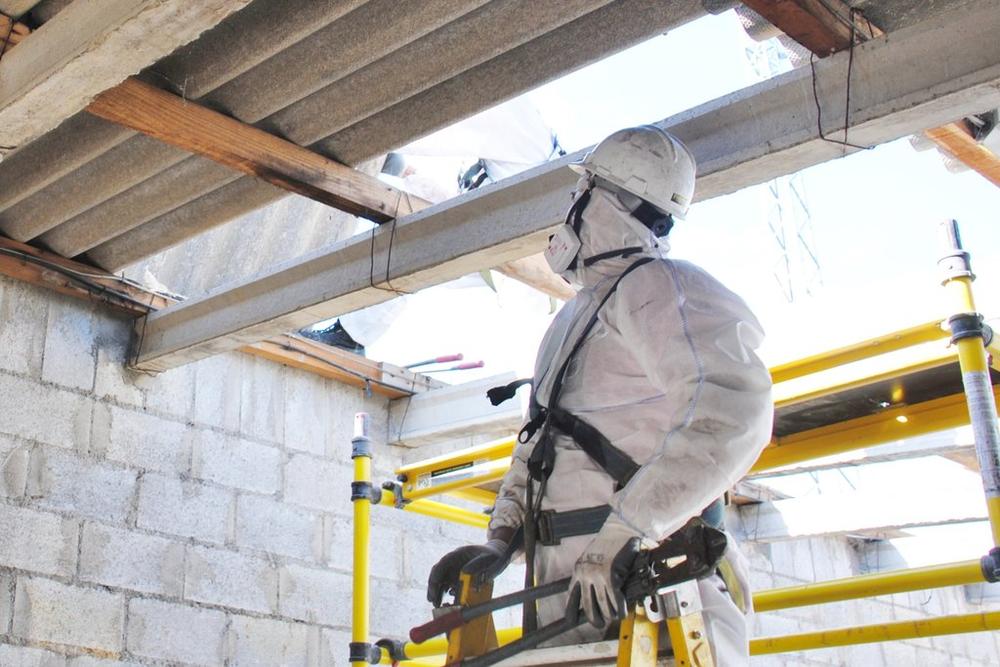Why Asbestos Testing is Necessary for Safeguarding Your Wellness
Why Asbestos Testing is Necessary for Safeguarding Your Wellness
Blog Article
The Full Refine of Accredited Asbestos Evaluating to Make Certain Residential Property Conformity
In the realm of building monitoring and conformity, the procedure of recognized asbestos testing stands as a critical element to guarantee the safety and security and wellness of owners. From the first assessment to the final interpretation of results, each stage plays an essential duty in figuring out the presence of asbestos within a residential property.
Accredited Asbestos Testing: Preliminary Evaluation
In conducting the initial analysis for approved asbestos screening, a careful exam of the building's materials is essential to accurately determine potential asbestos-containing products. This critical step involves visually inspecting all areas of the building, consisting of ceilings, walls, floor covering, insulation, and various other structure products that might nurture asbestos. Special interest is offered to products that are prone to damage or disruption, as these circumstances can launch damaging asbestos fibers right into the air. Furthermore, sampling of suspected materials may be needed to verify the presence of asbestos with laboratory analysis.
Recognized asbestos assessors adhere to strict procedures established by governing bodies to guarantee the precision and dependability of the testing process. By meticulously documenting searchings for and utilizing innovative screening methods, assessors can give homeowner with a detailed report detailing the presence of asbestos, if any kind of, and the suggested steps for mitigation or elimination. This preliminary evaluation establishes the foundation for subsequent activities to resolve asbestos worries and make sure the safety and conformity of the property.
Sample Collection Procedures for Asbestos Testing
Reliable sample collection treatments are vital in guaranteeing exact asbestos testing outcomes and compliance with regulative standards. When gathering examples for asbestos testing, it is crucial to comply with rigorous protocols to decrease the risk of contamination and make sure the reliability of the results.
To start with, it is essential to determine the suspected asbestos-containing products (ACMs) and focus on sampling areas based upon factors such as the material's problem, accessibility, and capacity for disruption. Asbestos Testing. Samples need to be collected from different places within the property to offer a thorough assessment of asbestos presence
During example collection, licensed specialists should wear suitable individual safety tools (PPE) to guard against asbestos exposure. They should utilize clean devices, such as non reusable handwear covers and plastic sheeting, to avoid cross-contamination in between samples. Examples should be carefully collected utilizing a specified technique, such as damp wiping or coring, and safely sealed in closed containers to maintain their integrity throughout transportation to the laboratory for evaluation.
Laboratory Evaluation Refine for Asbestos Examples
Upon conclusion of the sample collection process, the asbestos examples are meticulously carried to approved research laboratories for thorough evaluation. At the lab, trained technicians deal with the samples with extreme treatment to avoid any cross-contamination or example degradation. The initial step in the research laboratory evaluation process is example prep work, where the collected samples are thoroughly processed to remove the asbestos fibers. Asbestos Testing. This action is important to make certain accurate cause the subsequent analysis.

When the evaluation is total, a comprehensive record is produced, laying out the findings and verifying whether asbestos is existing, the type of asbestos fibers determined, and the concentration levels. This info like it is critical for property owners to take the required steps to guarantee conformity with asbestos guidelines and secure the wellness of residents.

Reporting and Interpretation of Asbestos Test Results
Recognized asbestos testing research laboratories provide comprehensive records that supply essential insights into the visibility, kind, and concentration levels of asbestos fibers found in examples gathered from residential or commercial properties. These reports are crucial for homeowner and managers to comprehend the risk presented by asbestos and make informed choices regarding its administration or elimination. The records commonly consist of details on the approaches utilized for testing, the locations where samples were taken, the sort of asbestos determined (such as chrysotile, amosite, or crocidolite), and the concentration degrees of asbestos fibers found.
Translating these results calls for experience to analyze the prospective health threats related to asbestos exposure, determine the proper strategy, and make sure regulative conformity (Asbestos Testing). Depending on the findings, referrals may range from proceeded monitoring and maintenance to encapsulation or complete asbestos reduction. Residential property owners ought my blog to meticulously examine these reports and speak with asbestos experts to establish a comprehensive strategy for resolving any type of asbestos issues determined
Guaranteeing Property Compliance With Asbestos Rules
To maintain adherence with asbestos policies, building owners should carefully apply measures to make sure compliance with suitable legislations and standards. As soon as asbestos is identified, home owners should comply with asbestos management plans that overview correct control, elimination, or encapsulation treatments to stop exposure and spread of asbestos fibers.
Homeowner should provide asbestos awareness training to staff members and owners to reduce the risk of asbestos exposure and ensure proper handling of products that may contain asbestos. In addition, it is crucial to stay educated regarding any type of updates or modifications in asbestos policies to adjust monitoring methods this content appropriately. By proactively addressing asbestos conformity demands, homeowner can create a secure atmosphere for residents and alleviate potential lawful and health and wellness risks related to asbestos exposure.
Conclusion
To conclude, approved asbestos testing is an essential process for making certain residential property conformity with policies. The first evaluation, sample collection treatments, laboratory evaluation, and interpretation of outcomes are all essential action in this process. By adhering to these procedures, home proprietors can identify and attend to any kind of asbestos risks present, safeguarding the health and safety and security of residents and maintaining compliance with regulatory demands.
Report this page